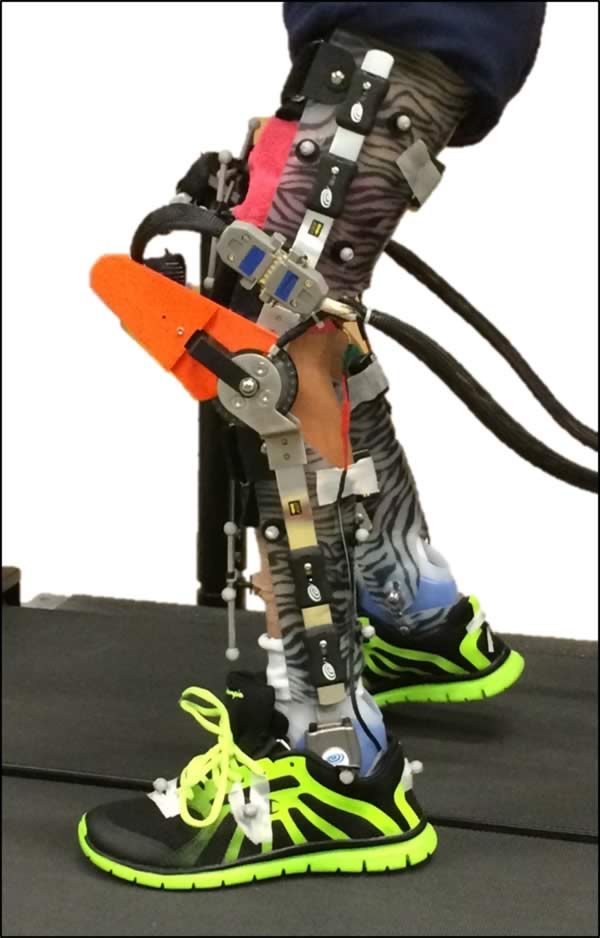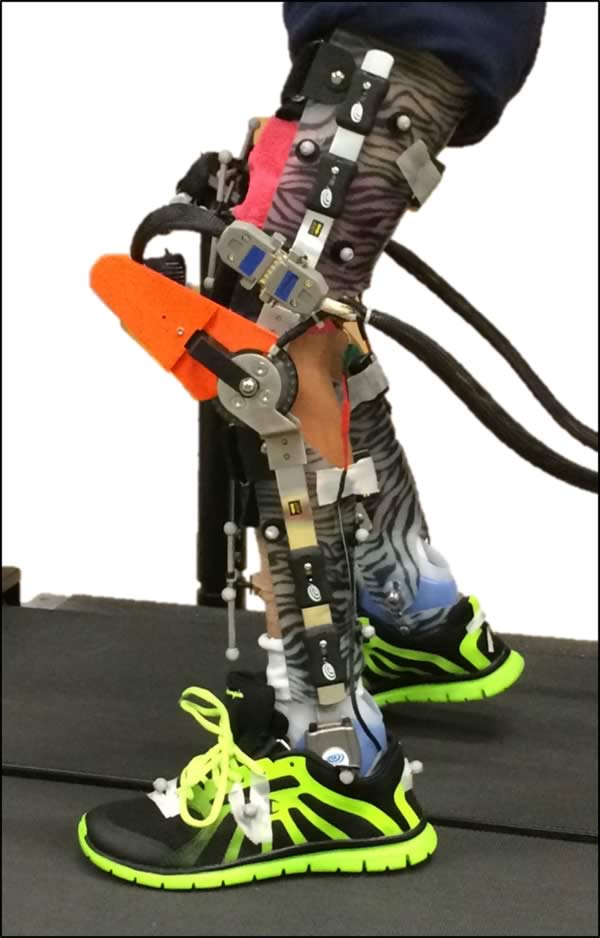
Bethesda, Maryland–(ENEWSPF)–August 25, 2017. Researchers from the NIH Clinical Center Rehabilitation Medicine Department have created the first robotic exoskeleton specifically designed to treat crouch (or flexed-knee) gait in children with cerebral palsy by providing powered knee extension assistance at key points during the walking cycle.
Crouch gait, the excessive bending of the knees while walking, is a common and debilitating condition in children with cerebral palsy. Despite conventional treatments (including muscle injections, surgery, physical therapy, and orthotics), crouch gait can lead to a progressive degeneration of the walking function, ultimately resulting in the loss of walking ability in roughly half of adults with the disorder.
The NIH Clinical Center researchers tested their prototype powered knee exoskeleton in a cohort study to:
- Determine if motorized knee extension assistance safely and effectively reduced crouch gait during walking in ambulatory children with cerebral palsy.
- Evaluate its effect on voluntary muscle activity to determine whether children continued to use their own muscles during walking with motorized assistance.
- Quantify short term alterations in lower limb gait biomechanics in response to robotic knee extension assistance.
The study followed seven individuals between the ages of 5 and 19 who were diagnosed with crouch gait from cerebral palsy and had Gross Motor Function Classification System levels I-II, meaning each could walk at least 30 feet without use of a walking aid.
Walking with the exoskeleton was well-tolerated with all participants able to walk independently without a mobility aids or therapist assistance with six doing so in the first practice session. Improvements in knee extension were observed in six participants with gains (8-37°) similar to or greater than average improvements reported from invasive surgical interventions. Importantly, the gains in knee extension occurred without a reduction in knee extensor muscle activity, indicating that these participants worked with the exoskeleton rather than offloading the task of straightening the leg during walking to the robot.
“Most wearable exoskeletons have been designed for adults with paralysis, with the exoskeleton replacing the lost function of the user’s. We sought to create a device that could safely and effectively improve the posture of children with crouch gait while they walked,” said Thomas Bulea, Ph.D., the principal investigator of the study and staff scientist in the NIH Clinical Center Department of Rehabilitation Medicine. “The improvements in their walking, along with their preserved muscle activity, make us optimistic that our approach could train a new walking pattern in these children if deployed over an extended time. This study paves the way for the exoskeleton’s use outside the clinic setting, greatly increasing the amount and intensity of gait training, which we believe is key to successful long-term outcomes in this population.”
This study is the first step toward the long-term goal of implementing a novel device-based approach to treating crouch gait, and suggests that powered knee exoskeletons should be investigated as an alternative to or in conjunction with conventional treatments. The results of this study provide evidence to support further device development and larger controlled intervention studies of pediatric exoskeleton efficacy for gait rehabilitation in cerebral palsy and other disorders.
Cerebral palsy is the most prevalent childhood movement disorder in the U.S. with approximately 10,000 new cases diagnosed each year. It is caused by a brain injury or abnormality in infancy or early childhood that disrupts the control of movement, posture, and balance.
About the NIH Clinical Center: The NIH Clinical Center is the clinical research hospital for the National Institutes of Health. Through clinical research, clinician-investigators translate laboratory discoveries into better treatments, therapies and interventions to improve the nation’s health. More information: https://clinicalcenter.nih.gov.
About the National Institutes of Health (NIH): NIH, the nation’s medical research agency, includes 27 Institutes and Centers and is a component of the U.S. Department of Health and Human Services. NIH is the primary federal agency conducting and supporting basic, clinical, and translational medical research, and is investigating the causes, treatments, and cures for both common and rare diseases. For more information about NIH and its programs, visit www.nih.gov.
Source: http://nih.gov









